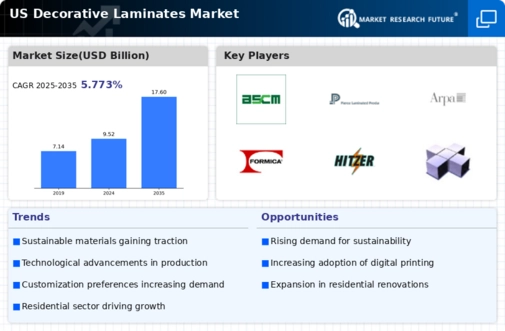Increased Consumer Awareness
Consumer awareness regarding interior design and aesthetics is significantly influencing the decorative laminates market. As individuals become more informed about design trends and the benefits of using decorative laminates, their purchasing decisions are increasingly driven by quality and style. The market is witnessing a shift towards premium products, with consumers willing to invest in high-quality laminates that offer both functionality and visual appeal. This trend is reflected in the rising sales figures, with the decorative laminates market expected to reach $10 billion by the end of 2025. Furthermore, the emphasis on eco-friendly materials is prompting consumers to seek laminates that align with their values, thereby driving innovation and sustainability within the industry.
Rising Construction Activities
The decorative laminates market experiences a notable boost due to the increasing construction activities across the United States. As urbanization continues to expand, the demand for residential and commercial buildings rises, leading to a greater need for interior design solutions. Decorative laminates are favored for their aesthetic appeal and durability, making them a popular choice among architects and designers. In 2025, the construction sector is projected to grow by approximately 5.5%, which directly influences the decorative laminates market. This growth is further supported by government initiatives aimed at infrastructure development, which enhances the market's potential. As a result, the decorative laminates market is likely to benefit from this upward trend in construction, providing opportunities for manufacturers and suppliers to expand their offerings.
Growth in the Furniture Industry
The decorative laminates market is closely linked to the growth of the furniture industry in the United States. As furniture manufacturers increasingly incorporate decorative laminates into their products, the demand for these materials is expected to rise. The furniture sector is projected to grow at a rate of 4% annually, driven by consumer preferences for stylish and functional home furnishings. Decorative laminates provide an ideal solution for furniture applications, offering a wide range of designs and finishes that appeal to modern consumers. This synergy between the furniture industry and the decorative laminates market presents opportunities for collaboration and innovation, potentially leading to new product developments that cater to evolving consumer tastes.
Rising Demand for Eco-Friendly Products
The decorative laminates market is witnessing a surge in demand as consumers become increasingly environmentally conscious. This trend is prompting manufacturers to develop laminates that utilize sustainable materials and production methods. The market is responding to this shift by introducing products that are not only aesthetically pleasing but also align with eco-friendly standards. In 2025, it is estimated that the share of eco-friendly decorative laminates will account for approximately 30% of total sales. This growing preference for sustainable options is likely to drive innovation within the decorative laminates market, encouraging companies to invest in research and development to create greener alternatives that meet consumer expectations.
Technological Innovations in Production
Technological advancements in the production processes of decorative laminates are reshaping the market landscape. Innovations such as digital printing and advanced surface treatments enhance the aesthetic qualities and durability of laminates, making them more appealing to consumers. These technologies allow for greater customization and design flexibility, catering to the diverse preferences of end-users. As manufacturers adopt these cutting-edge techniques, the decorative laminates market is likely to witness an increase in product offerings, which could lead to a projected growth rate of 6% annually through 2025. This technological evolution not only improves product quality but also streamlines production efficiency, ultimately benefiting both manufacturers and consumers.
























Leave a Comment